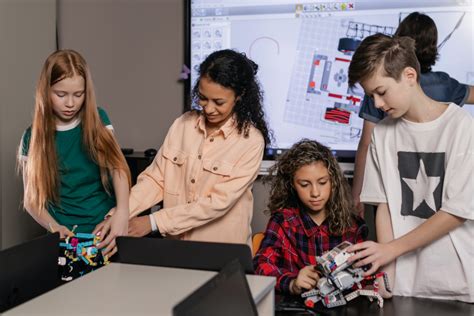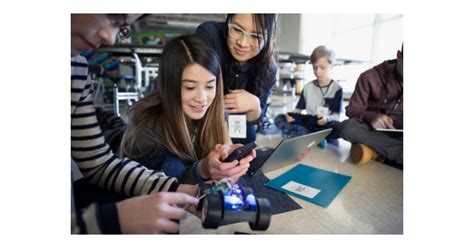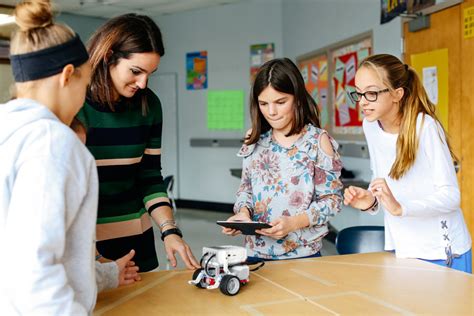The ISTE Standards for Educators are a vital framework designed to empower teachers with the skills and knowledge needed to effectively integrate technology into their teaching practices. In an era where digital tools and resources are becoming increasingly essential in education, these standards provide a roadmap for educators to enhance their instructional strategies, engage students, and foster innovative learning environments. This article offers a comprehensive analysis of the ISTE Standards, exploring their significance in modern education, breaking down each standard in detail, and examining their practical applications in the classroom. By understanding and adopting these standards, educators can better prepare themselves to meet the evolving demands of 21st-century education.
Discover more about this topic with electrapk.com in detail.
1. Introduction to ISTE Standards for Educators
The ISTE Standards for Educators provide a roadmap for teachers navigating the ever-changing educational landscape through the effective integration of technology. Created by the International Society for Technology in Education (ISTE), these standards encourage educators to rethink their roles, professional practices, and teaching methods in the digital age. The standards highlight key skills educators need to flourish in contemporary educational environments, emphasizing the importance of being lifelong learners, facilitators of learning, and leaders in utilizing technology to enhance education.
These standards are not just a set of guidelines; they represent a vision for the future of teaching and learning. They encourage educators to leverage technology to design engaging, student-centered learning experiences that foster critical thinking, creativity, and collaboration. By adopting these standards, educators can more effectively address the diverse needs of their students, prepare them for success in a digital world, and continuously adapt their teaching practices to meet new challenges and opportunities.
The ISTE Standards for Educators are structured into seven overarching categories, each addressing distinct facets of teaching and learning. This comprehensive framework empowers educators to elevate their practice, foster deeper student engagement, and spearhead innovation within their schools and communities.

2. Importance of ISTE Standards in Modern Education
The ISTE Standards for Educators are essential in today’s educational landscape. They provide a comprehensive framework that addresses the evolving needs of the digital age, a reality where technology is no longer a luxury but a necessity. These standards equip educators with the tools to navigate the complexities of integrating digital tools into their teaching practices. Their emphasis on digital literacy, critical thinking, and problem-solving ensures that students are prepared for a world where these skills are crucial for success.
These standards empower educators to craft dynamic and engaging learning environments that cater to a range of learning styles and needs. By encouraging teachers to move beyond traditional methods, the ISTE Standards foster innovation and creativity in instructional practices. They also support professional growth, helping educators stay abreast of emerging technologies and pedagogical approaches. Ultimately, these standards play a crucial role in equipping education systems worldwide to prepare students for success in our increasingly digital and interconnected world.

3. Detailed Breakdown of Each ISTE Standard
The ISTE Standards for Educators are organized into seven distinct areas, each dedicated to a specific aspect of teaching within a digital environment.
Educators are committed to ongoing professional growth. They achieve this by collaborating with colleagues, both sharing and acquiring knowledge. This includes investigating effective and innovative teaching approaches, especially those that harness technology to enhance student learning outcomes.
Educators, as leaders, actively seek out opportunities to promote equitable access to technology, digital content, and learning opportunities. This commitment ensures that all students, regardless of their backgrounds or needs, can benefit from these resources and thrive in their educational journeys.
Educators play a crucial role in inspiring students to make positive contributions and engage responsibly in the digital realm. They prioritize fostering digital literacy and promoting ethical conduct online.
Collaboration: Educators are committed to working together with colleagues and students, leveraging technology to enhance learning, explore new resources, and exchange ideas.
Educators, as designers, create genuine learning experiences that are tailored to students’ individual needs and preferences. They acknowledge and embrace the diversity of learners, adapting their activities and learning environments to accommodate this variability.
Educators, acting as facilitators, leverage technology to guide student learning. Through engaging and innovative approaches, they ensure that students attain their learning objectives.
Educators leverage data to inform their teaching strategies and deliver timely feedback to students, enabling them to reach their full potential.
These standards serve as a comprehensive framework for educators, enabling them to design learning environments that are both highly effective and equip students with the skills needed to thrive in the future.

4. Practical Applications of ISTE Standards in the Classroom
By implementing the ISTE Standards in the classroom, educators can shift from traditional teaching methods to a dynamic, technology-infused learning environment. For example, as Learners, teachers can actively participate in ongoing professional development, such as online courses or digital communities, to constantly enhance their skills. In their role as Leaders, they can champion equitable access to digital resources, ensuring that all students have the opportunity to benefit from technology-driven learning experiences.
As Citizens, educators can guide students to become responsible digital citizens, empowering them to navigate the online world safely and ethically. In their role as Collaborators, educators can work alongside colleagues to create engaging, cross-curricular projects that utilize technology, fostering teamwork and encouraging creative expression.
Designers, Facilitators, and Analysts: The Educator’s Trifecta
Educators can act as Designers, crafting personalized learning experiences through the use of digital tools. These tools can cater to a range of learning styles, ensuring that every student feels supported. By taking on the role of Facilitators, educators can leverage interactive platforms to engage students in active learning activities. This fosters critical thinking and promotes deeper understanding. Finally, as Analysts, educators can use data from educational software to inform their instruction. This data allows them to tailor their teaching strategies and provide timely, constructive feedback, ultimately enhancing student outcomes.
5. Benefits of Adopting ISTE Standards for Educators
The ISTE Standards provide educators with a wealth of benefits that elevate both teaching practices and student learning outcomes. By adhering to these standards, educators remain at the forefront of educational technology, ensuring their teaching methods are consistently relevant and effective in our dynamic digital environment. This not only fosters their professional growth but also elevates student engagement as lessons become more interactive and personalized to meet individual needs.
These standards promote a collaborative teaching environment, encouraging educators to share resources, strategies, and innovations with their colleagues. This fosters a culture of continuous improvement. Furthermore, the emphasis on digital citizenship equips teachers to prepare students for the challenges and responsibilities of the online world, promoting ethical and informed technology use.
Furthermore, by embracing data-driven approaches, educators can gain a more precise understanding of student progress. This allows for tailored instruction, ensuring that teaching strategies effectively address individual learning goals. In conclusion, the ISTE Standards equip educators with the tools to deliver exceptional education that is both cutting-edge and welcoming to all learners.
6. Challenges and Solutions in Implementing ISTE Standards
Implementing the ISTE Standards can be challenging, but with the right strategies, these obstacles can be overcome. One common challenge is the varying levels of technological proficiency among educators. Not all teachers are equally comfortable using digital tools, which can hinder effective technology integration in the classroom. To address this, schools can provide tailored professional development and ongoing support, enabling educators to develop the necessary skills at their own pace.
A significant obstacle is the insufficient access to technology and resources, particularly in schools with limited funding. Without the necessary tools, even the most adept teachers may find it difficult to meet educational standards. Addressing this issue requires seeking grants, establishing partnerships with technology companies, and advocating for increased funding to guarantee that all students and educators have the resources they need to thrive.
Another major obstacle is time. Teachers are already extremely busy, and incorporating new technology into lesson plans and mastering its use takes valuable time they may not have. Schools can alleviate this issue by providing designated time for teachers to experiment with and implement technology in their teaching materials.
Resistance to change is a frequent hurdle. Educators, accustomed to established methods, may hesitate to embrace new approaches or technologies. Cultivating a culture of innovation, emphasizing the advantages of educational technology, and showcasing the positive experiences of other educators can facilitate this transition and promote a more receptive attitude towards the standards.
7. Case Studies of Successful ISTE Standard Integration
The successful integration of ISTE Standards in various schools demonstrates their positive influence on teaching and learning. At Lincoln High School, educators embraced the Collaborator and Designer standards by incorporating project-based learning units. These units utilized digital tools to facilitate collaborative student projects, fostering enhanced student engagement, problem-solving skills, and teamwork.
Maplewood Elementary School provides an illustration of personalized learning in action. By leveraging the Facilitator and Analyst standards, teachers were able to utilize adaptive learning technologies effectively. Data gleaned from these tools empowered teachers to tailor instruction to meet the unique needs of each student. This personalized approach yielded notable improvements in both student performance and satisfaction.
Furthermore, Greenwood Academy emphasized the Citizen standard by integrating digital citizenship instruction into its curriculum. This initiative empowered students to comprehend and engage in responsible online conduct, equipping them for the intricacies of the digital landscape. These case studies showcase the tangible advantages of adopting ISTE Standards, resulting in a more effective and technologically enriched educational experience.
8. Resources and Tools for Meeting ISTE Standards
Educators can effectively meet the ISTE Standards by leveraging a range of resources and tools. Professional development platforms, such as ISTE’s own learning offerings, provide specialized training and certification to enhance teachers’ technology integration skills. Online communities and forums, including EdTech Twitter chats and educator groups on LinkedIn, offer collaborative spaces for sharing best practices and overcoming challenges.
Educational technology tools play a vital role in modern classrooms. Platforms like Google Classroom, Microsoft Teams, and Edmodo enhance collaboration and communication between students and teachers. Adaptive learning platforms, such as Khan Academy and DreamBox, offer personalized learning experiences, aligning with the Facilitator and Designer standards. Furthermore, formative assessment platforms, like Quizizz and Socrative, provide educators with valuable tools for assessing student progress. These platforms enable teachers to gather and analyze data, informing their instructional decisions and tailoring their approach to individual student needs.
Furthermore, digital citizenship resources provided by organizations like Common Sense Education empower educators to guide students in responsible online conduct, aligning with the Citizen standard. These invaluable resources and tools are crucial for effectively implementing the ISTE Standards and enriching the teaching and learning experience.
9. Future Trends and the Evolution of ISTE Standards
The ISTE Standards are designed to be dynamic, evolving in step with technological advancements and changes in educational practices. As technology continues to develop, future trends will likely prioritize the integration of cutting-edge tools like artificial intelligence, virtual reality, and augmented reality into the classroom. These technologies hold the potential to transform learning experiences, offering immersive environments and personalized instruction, directly aligning with the Designer and Facilitator standards.
The evolving landscape of education, with its growing emphasis on hybrid and remote learning, necessitates a continued focus on addressing the unique challenges and opportunities presented by digital and blended learning settings. The standards will be enhanced to better support digital communication, collaboration, and engagement, further strengthening the Collaborator and Leader standards.
Furthermore, the importance of data privacy and security will increase, driven by anxieties about digital citizenship and the ethical use of technology. This trend will likely result in the development of more comprehensive guidelines within the Citizen standard to promote the safe and responsible use of technology.
These standards will also adapt to the ongoing need for educators to be lifelong learners. Continuous professional development and current knowledge of technological trends will be essential, reinforcing the Learner standard. Overall, the evolution of the ISTE Standards will guarantee their continued relevance, helping…
10. Conclusion and Final Thoughts
The ISTE Standards for Educators play a crucial role in fostering a contemporary, technology-driven educational landscape. They provide a robust framework for seamlessly integrating digital tools into teaching methodologies, ensuring educators are adequately prepared to meet the challenges of the 21st century. Emphasizing ongoing professional development, collaboration, and the effective utilization of technology, these standards empower educators to craft captivating and personalized learning experiences for their students.
Although implementing the ISTE Standards faces obstacles like diverse technological skills, limited resources, and resistance to change, their benefits are undeniable. These standards encourage a more dynamic and adaptable teaching method, cultivate a culture of innovation, and equip students to navigate the complexities of a digital environment.
The ISTE Standards are a dynamic framework, constantly evolving to reflect advancements in technology and education. Educators who adopt and embrace these standards will be well-equipped to navigate future changes and foster positive learning experiences in their classrooms. The ISTE Standards are not merely guidelines, but a roadmap for enhancing the teaching and learning process.
electrapk.com
